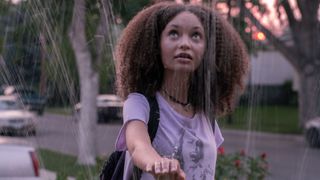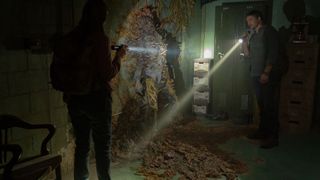GamesRadar+ Verdict
The Last of Us kicks off with an extra-long episode that gives Joel a heartbreaking prologue while simultaneously highlighting the promise of Ellie and her story to come.
Why you can trust GamesRadar+
Warning: Spoilers for The Last of Us premiere follow. If you haven't seen the episode, look away now!
The Last of Us has a thankless task ahead of it. HBO’s adaptation of Naughty Dog’s PlayStation classic not only has to appeal to a legion of fans who will nitpick every minor change from the games, but it also has to stand out among a crowded marketplace of post-apocalyptic dramas teeming with zombie-like threats. Fortunately, the premiere does the almost miraculous: it expands on the games – and often betters them.
The Last of Us’ first scene is a sobering reminder of its mission statement: this is a TV show first and a direct adaptation second. The opening minutes focuses on a team of scientific experts debating the likelihood of a viral fungus epidemic spreading across the world. Set in the 1960s, the scene – which does not come from the games – is dryly written and doesn’t skimp on the heavy-handed exposition as it introduces the show’s main threat and the world to follow. It won’t send pulses racing; instead, it slowly begins ratcheting up the tension of an episode that fast becomes a horror film in miniature.
When you're lost in the darkness...

A jump forward in time to 2003 introduces our primary characters and changes the tone. On his 36th birthday, Joel (Pedro Pascal, whose accent fluctuates between his own and a shaky Southern twang) sets out for a construction job with his brother Tommy (Gabriel Luna), while Joel’s daughter Sarah (Nico Parker) goes about her school day.
The Last of Us rapidly takes a turn for the Lynchian as Joel and Sarah’s idyllic slice of suburban life is punctuated with the noise and panic of something going very, very wrong in the background. In one particularly unsettling moment – and evidence of the creative team’s early pitch-perfect instincts on when to elaborate on the games – an elderly woman succumbs to the tendrils of the fungal infection and violently jerks in her seat. It’s all blurred in the background of a close-up. When Sarah later discovers her body, you’ll be watching through your fingers.
The first half of the episode broadly follows the game’s prologue section while feeling not too dissimilar to A Quiet Place’s Day One sequences (ironically a film that took inspiration from The Last of Us). Joel and Sarah attempt to head out of town amid congested highways and pitch-black streets. Director and co-showrunner Craig Mazin’s masterful use of the camera depicts all hell breaking loose from Sarah’s point of view, adding to the suffocating tone as things go from bad, to worse, to catastrophic. That’s accentuated further by Gustavo Santaolalla’s powerful and restrained score. The gentle twangs of a banjo are deployed effectively throughout to intensify, but never overpower, the episode’s more emotional beats.
Then, that moment comes. A soldier approaches Joel and a wounded Sarah. After some miscommunication, Joel’s daughter is shot and dies in his arms. Thanks to the show spending more time with Sarah than in the games, it’s a gut punch that hurts even more this time around. The emotional context is aided by both Pedro Pascal – heavy with grief, delivering an incredibly raw and intense performance – and Nico Parker’s peppy presence. It speaks volumes that her loss is not only felt by Joel, but ultimately by the show itself.
...look for the light

Where the first half echoes A Quiet Place, the second feels like an even bleaker take on The Walking Dead. Twenty years after Sarah’s death, citizens are hemmed into ‘QZs’ (Quarantine Zones) while mushroom-ravaged clickers and raiders roam outside the walls in Boston. Terrorist group the Fireflies are additional wildcards, with figures like firebrand leader Marlene (Merle Dandridge) trying to blow up the system from within. When even shoelaces cost ration cards and people are executed for leaving the QZ, it’s little wonder that Joel (his haggard, well-worn face garnished with a salt-and-pepper beard) and partner Tess (Anna Torv) engage in shady deals in back alleys and dimly-lit rooms.
It’s here where the episode runs out of steam slightly. After the relentless pressure of the horror-heavy first half, the latter portion feels like a safer pilot – and potentially the result of two episodes being squished together (the initial episode order was ten, but the series ultimately ended up being only nine). On top of that, there’s some fatigue due to the fact The Last of Us exists alongside a multitude of other dystopian shows, and the premiere has a bumper 80-minute runtime that should have been cut down in the editing booth. Considering that the game’s co-lead Ellie (Bella Ramsey) and the Fireflies are introduced as afterthoughts, it’s clear there’s a pacing problem.
Despite the slower tempo, the episode ends on a high note. In an extended sequence, Joel and Tess hunt down Robert, a slimy smuggler who has pawned off Joel’s truck battery just as he was about to head out to find his lost brother. Along the way, they cross paths with Ellie, her hardened mix of steel and moxie enough to put any lingering doubts over Ramsey’s casting to bed. A pulsating series of scenes serves as a blueprint for the show moving forward: a melancholy journey that sees its characters delicately walking a tightrope between violent outbursts and tense standoffs in a world that wants them dead.
Will The Last of Us make everyone happy? On this evidence, it’s certainly making a good stab of it. Joel and Ellie’s story is only just getting started, but everything in the premiere – from the terrifying outbreak through to Sarah’s crushing death – is proof that the series is in the hands of skillful, smart storytellers (the game’s creator Neil Druckmann serves as the second co-showrunner) who are able to handle the source material with the required care – and with the confidence to make more significant tweaks when necessary.
The Last of Us streams Sundays on HBO and HBO Max and Mondays in the UK on Sky Atlantic and NOW TV. For more from the HBO series, check out our guide to the major Last of Us episode 1 changes from the games and a terrifying look at the Cordyceps fungus. Discover when the next episode is dropping with our Last of Us release schedule.
More info
| Genre | Drama |
I'm the Senior Entertainment Writer here at GamesRadar+, focusing on news, features, and interviews with some of the biggest names in film and TV. On-site, you'll find me marveling at Marvel and providing analysis and room temperature takes on the newest films, Star Wars and, of course, anime. Outside of GR, I love getting lost in a good 100-hour JRPG, Warzone, and kicking back on the (virtual) field with Football Manager. My work has also been featured in OPM, FourFourTwo, and Game Revolution.


